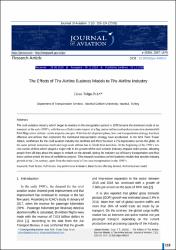The Effects of The Airline Business Models to The Airline Industry
Abstract
The civil aviation industry which began to develop in the deregulation period in 1978 became the dominant mode of air transport in the early 1990’s, with the use of hub (centre airport of a flag carrier airline) and spoke (connection destinations from flag carrier airlines’ centre airport) concepts. With this development phase, low cost transportation strategy has been effective and airlines that implement the traditional transportation strategy have accelerated. In the 9/11 Twin Tower Attack, confidence for the civil aviation industry has declined and there has been a 7% depreciation across the globe. In the same period, numerous small and large scale airlines had to finish their activities. At the beginning of the 1990’s low cost carrier airlines which played a major role in the growth of the civil aviation industry dropped ticket prices, allowing people from all trips about the stages to embark on the aircraft, taking the industry out of luxury transportation and thus these carriers ended the loss of confidence process. This research examines airline business models that provide industry growth in the 21st century, apart from the main trend of low cost transportation in the 1990’s.
Volume
2Issue
2Collections
The following license files are associated with this item:


















